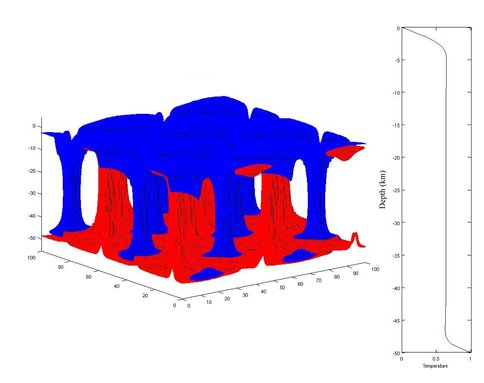2009 Annual Science Report
 NASA Jet Propulsion Laboratory - Titan
Reporting | JUL 2008 – AUG 2009
NASA Jet Propulsion Laboratory - Titan
Reporting | JUL 2008 – AUG 2009
Task 1.1.2 Models of the Internal Dynamics: Formation of Liquids in the Subsurface and Relationships With Cryovolcanism
Project Summary
Prebiotic compounds can be formed on the Titan surface when organics mix and react with liquid water in a cryovolcanic context, where subsurface water “erupts” onto the cold surface.
Project Progress
Co-Investigator Christophe Sotin has prepared a numerical code to simulate the formation of liquids in the Titan subsurface. The code has been set up with Titan parameters and the first 3D calculations have been run (Figure 1). The major difficulty is to properly handle the viscosity variations. Right now we have reached steady state flow for viscosity variations of one order of magnitude. The spatial mesh has to be adapted such that viscosity variations across one grid volume do not exceed a threshold above which convergence is not ascertained. The thickness of the ice layer is fixed to 50 km and the top and bottom boundaries are isothermal boundaries. The geometry is driven by the instability of hot plumes forming at the lower thermal boundary layer. The closer we get to a realistic activation energy of 50 kJ/mole, the larger the mean temperature of the convective layer. The size of the plumes decreases with increasing values of the activation energy. It is expected that a realistic case will be achieved by December 2009. The results will be used to map places where ices such as clathrates and ammonia hydrates can melt in the upwelling plumes.
Figure 1. Figure 1: 3D simulation of heat transfer within Titan’s icy shell. The simulation assumes a 50 km thick crust overlying an ocean. Hot plumes form at the interface with the ocean whereas cold plumes form at the surface boundary layer. The temperature-dependent viscosity kills the symmetry of the convective pattern and the horizontally-averaged temperature profile (right panel) shows that the convective temperature is larger than the mean temperature. This simulation was carried out to test the convergence rate on the super computer and shows that the viscosity is only weakly temperature dependent.
-
PROJECT INVESTIGATORS:
-
RELATED OBJECTIVES:
Objective 1.1
Formation and evolution of habitable planets.
Objective 2.2
Outer Solar System exploration
Objective 3.1
Sources of prebiotic materials and catalysts
Objective 3.2
Origins and evolution of functional biomolecules
Objective 3.3
Origins of energy transduction

